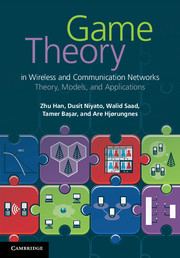Book contents
- Frontmatter
- Contents
- Preface
- 1 Introduction
- 2 Wireless networks: an introduction
- Part I Fundamentals of game theory
- Part II Applications of game theory in communications and networking
- 9 Cellular and broadband wireless access networks
- 10 Wireless local area networks
- 11 Multi-hop networks
- 12 Cooperative-transmission networks
- 13 Cognitive-radio networks
- 14 Internet networks
- References
- Index
14 - Internet networks
from Part II - Applications of game theory in communications and networking
Published online by Cambridge University Press: 25 October 2011
- Frontmatter
- Contents
- Preface
- 1 Introduction
- 2 Wireless networks: an introduction
- Part I Fundamentals of game theory
- Part II Applications of game theory in communications and networking
- 9 Cellular and broadband wireless access networks
- 10 Wireless local area networks
- 11 Multi-hop networks
- 12 Cooperative-transmission networks
- 13 Cognitive-radio networks
- 14 Internet networks
- References
- Index
Summary
Communication networks such as the Internet are becoming more and more dependent on the interactions of intelligent devices that are capable of autonomously operating within a highly dynamic and rapidly changing environment. The dynamism and complexity of Internet networks is a consequence of their size, heterogeneity, traffic diversity, and decentralized nature. Next-generation communication networks such as the future Internet are envisioned to be self-organizing, self-configuring, self-protecting, and self-optimizing. The applications and services that make use of these networks will also grow in complexity and impose stringent constraints and demands on network design: increased quality-of-service requirements for routing data, content distribution based on peer-to-peer networks, advanced pricing, and congestion control mechanisms, etc.
While these challenges were initially perceived with the emergence of the Internet, they are now essential in the design of every current and future network. To efficiently analyze and study such Internet-like networks, there is a need for a rich analytical framework such as game theory, whose models and algorithms can capture the numerous challenges arising in current and emerging communication networks. The challenges in designing Internet networks differ from those of their wireless counterparts in several aspects. In general, one does not need to worry about the reliability of the communication channel, as in the wireless case. But because Internet networks are generally composed of heterogeneous nodes having different capabilities and communicating over long paths and routes, the network size and as well as heterogeneity the nodes' capabilities, for example, play a role that is more critical in the design of Internet networks than in the wireless case.
- Type
- Chapter
- Information
- Game Theory in Wireless and Communication NetworksTheory, Models, and Applications, pp. 460 - 500Publisher: Cambridge University PressPrint publication year: 2011



